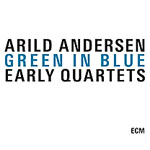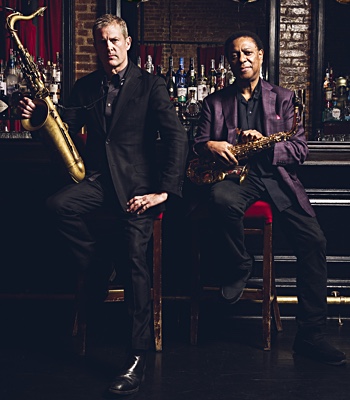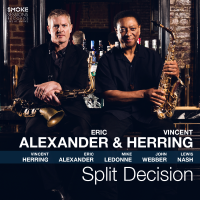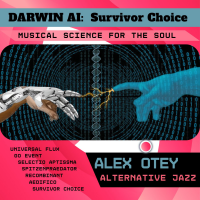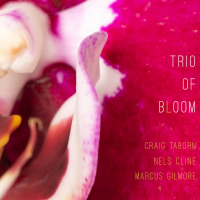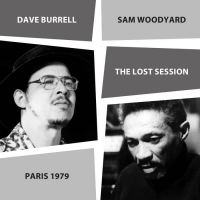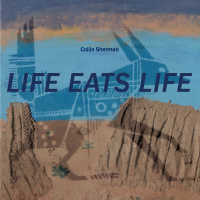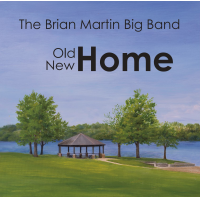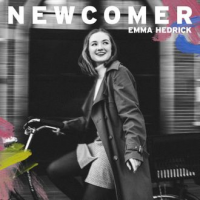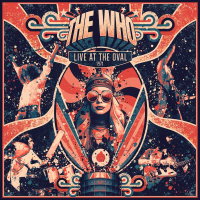Home » Jazz Articles » Extended Analysis » Arild Andersen: Arild Andersen: Green Into Blue - Early Quartets
Arild Andersen: Arild Andersen: Green Into Blue - Early Quartets
A pity, then, that while most of these albums have been available for many years on CD—Underwear, released only briefly on CD in Japan, is now available from ECM as a digital download—Andersen's first three recordings as a leader, featuring his vital mid-1970s quartet, have never been available on CD.
Until now. As part of ECM's recent Old & New Masters series, Green In Blue collects Clouds In My Head (1975), Shimri (1977) and Green Shading Into Blue (1978) together in one box, giving all of them their first appearance on CD. As classic as so many other ECM titles are from that time, it's difficult to believe that these three albums have remained so largely under the radar—making, as they do, an even stronger case for Andersen's importance in the emergence of Norway as a major contributor to the jazz canon—not just as a bassist, but as a composer and bandleader. These three recordings also introduced a number of players in Andersen's group, one—pianist Jon Balke—who has gone on to far greater import himself, and others who, based on their performances here, have sadly never achieved the international acclaim they so richly deserve, despite remaining active in their native Scandinavian countries.
 Music never emerges from a vacuum, and while the "Big Four" seemed to burst onto the scene with their ECM recordings, all of them were busy players on the Norwegian scene in the 1960s. Andersen and Christensen, in particular, were busy guns-for-hire, picking up work with American musicians touring Europe. As a freelancer, Andersen played with artists ranging from saxophonist Stan Getz to multi-instrumentalist Don Cherry, and spent considerable time in the United States between 1972 and 1974. As Steve Lake's informative essay, included in the box, explains, Andersen wrote most of the music for what would become both his ECM debut and his first album as a leader during a three month stay in the United States, recording it at Arne Bendiksen's studio in Oslo, Norway in early 1975, when the bassist was on the cusp of turning 30.
Music never emerges from a vacuum, and while the "Big Four" seemed to burst onto the scene with their ECM recordings, all of them were busy players on the Norwegian scene in the 1960s. Andersen and Christensen, in particular, were busy guns-for-hire, picking up work with American musicians touring Europe. As a freelancer, Andersen played with artists ranging from saxophonist Stan Getz to multi-instrumentalist Don Cherry, and spent considerable time in the United States between 1972 and 1974. As Steve Lake's informative essay, included in the box, explains, Andersen wrote most of the music for what would become both his ECM debut and his first album as a leader during a three month stay in the United States, recording it at Arne Bendiksen's studio in Oslo, Norway in early 1975, when the bassist was on the cusp of turning 30. In addition to recruiting a young Balke for Clouds In My Head, Andersen enlisted Knut Rissnæs, a saxophonist who, had the stars aligned more properly, might have become as famous as Garbarek. With a softer tone and less of the lilt that Garbarek would source from Norwegian folk music, while sharing a similar concern for the purity of every note (a perfect fit for ECM's sonic transparency), Rissnæs' playing is part of the collective fire driving Clouds. He delivers a suitably passionate solo on "Outhouse"—a hard-swinging Andersen original with a knotty, stop/start head that remains in the bassist's live repertoire to this day—setting a perfect context for the bassist's own lithely percussive solo. Elsewhere, on the more relaxed melancholy of "305 W 18 St"—a reference to the New York apartment belonging to singer Sheila Jordan that became the bassist's creative base—Rissnæs' flute evokes a wistful tone for a song that nevertheless sports an impressively virtuosic (and overdubbed) solo by Andersen, with Balke's inventive navigation of the bassist's folk-centric changes presaging even better things to come.
The American tradition remains a fundamental component. "Song For A Sad Day," a haunting, rubato original that, were it not for drummer Pål Thowsen's spare, textural playing and Andersen's supportive yet pliant approach, could be seen reinterpreted with straighter time as a smoky, late-night ballad, is another feature for Rissnæs' ardent tenor, while the equally supple "SIV," with Rissnæs switching again to flute, comfortably straddles the line between poignant form and greater interpretive freedom.
Thowsen is another player who seemed poised for greatness, but for whom the international acclaim of contemporary Jon Christensen seemed elusive. No Time For Time (Sonnet, 1976)—an album co-led with Christensen and also featuring Andersen and Rypdal— suggests that Thowsen was, in fact, one side of an equilateral percussion triangle (the third being Finnish drummer/composer Edward Vesala) that innovated a kind of temporal elasticity specific to Scandinavian music and which remains a global touchstone. Not that Thowsen is incapable of groove; like Christensen he, too, can swing, provide a subtle backbeat or achieve the Norwegian equivalent of funky. But an underlying looseness keeps the music grounded while largely avoiding the more direct approach coming from the other side of the Atlantic. "Cycles" mines Miles Davis' seminal quintet territory, in the years immediately preceding the landmark In a Silent Way (Columia, 1969), with Thowsen's quarter-note cymbal pulse the only constant as he interacts with Andersen's effortless linearity and Balke's staccato harmonic pushes.
Andersen has always cited fretless electric bass icon Jaco Pastorius as a seminal influence, but at the time of this recording, the American phenom had yet to emerge as a dominant force, making Andersen's effervescent displays of frightening technique all the more impressive. Few double-bassists—other than, perhaps, Weather Report co-founder and later ECM label-mate Miroslav Vitous—can match Andersen's supple muscularity without losing site of its inherent lyricism, even when playing at lightning speed. The powerful "The Sword Under His Wing," which would become one of the highlights of Andersen's Molde Concert (1982), closes Clouds In My Head with near-fusion energy, but without the electricity and excessive tendencies. Andersen's memorable melody opens up into a series of individual features, with Andersen delivering a career-defining solo improv of surprising dexterity and perfectionist execution, while never losing sight of compositional construction. Balke swings with breathtaking energy, and Rissnæs' modal soprano solo—closer, in its nasal tone, to Coltrane's evocation of an Indian reed instrument—and a rare spot for Thowsen maintains forward motion, even as the drummer pushes and pulls both rhythm and texture, provide an exhilarating closer to an album which covers a lot of ground in a scant 45 minutes, and is as vital a debut as any in ECM's mid-1970s catalog.
 With Balke and Rissnæs departing after Clouds, Andersen recruited Finnish saxophonist Juhani Aaltonen, an early member of Edward Vesala's groups heard on Satu (1977) and Nan Madol (1976)—two important ECM albums that introduced Vesala's organized chaos approach to writing. There's great beauty to be found amidst the late drummer's horn-heavy, large ensembles; but equally there's unfettered free play of reckless abandon; something to which Andersen was no stranger on Garbarek's Ayleresque, 1973, free jazz trio date with Vesala, Triptykon. But as big-toned and expressionistic as Aaltonen could be, he was equally capable of the kind of melodic intention so key to Andersen's music. Rounding out the quartet was Swedish pianist Lars Jansson, possessing a far softer touch and less idiosyncratic approach to accompaniment than Balke, but with his own kind of harmonic sophistication.
With Balke and Rissnæs departing after Clouds, Andersen recruited Finnish saxophonist Juhani Aaltonen, an early member of Edward Vesala's groups heard on Satu (1977) and Nan Madol (1976)—two important ECM albums that introduced Vesala's organized chaos approach to writing. There's great beauty to be found amidst the late drummer's horn-heavy, large ensembles; but equally there's unfettered free play of reckless abandon; something to which Andersen was no stranger on Garbarek's Ayleresque, 1973, free jazz trio date with Vesala, Triptykon. But as big-toned and expressionistic as Aaltonen could be, he was equally capable of the kind of melodic intention so key to Andersen's music. Rounding out the quartet was Swedish pianist Lars Jansson, possessing a far softer touch and less idiosyncratic approach to accompaniment than Balke, but with his own kind of harmonic sophistication. If anything, the more subdued Shimri moved further away from direct American influence and more towards Andersen's increasingly distinctive compositional voice; a reflection, perhaps, of Andersen writing back home in Norway rather than in the hustle and bustle of New York City. Unlike Clouds where Andersen is the sole composer, Shimri features one song by Jansson—the gentle "Vaggvisa För Hanna," a duet feature for piano and flute that occupies similar terrain as American pianist Art Lande's wonderful 1974 duet date with Garbarek, Red Lanta. Shimri also features the folkloric and aptly titled "Wood Song," a spontaneous composition that, with Aaltonen's wood flute and Thowsen's gentle percussion, proves that free improvisation absolutely needn't unapproachable.
The rest of the album, written by Andersen, is darker in tone and sparer in content than Clouds—though that doesn't preclude an underlying energy that simmers gently beneath pieces like the opening title track, where pliant time and slowly unfolding changes provide grist for Jansson's more overt classicism. Aaltonen enters with an economic lyricism equal to Garbarek as the piece ebbs and flows, both dynamically and temporally. Switching to soprano for the equally pliant but more harmonically ambiguous "No Tears," Aaltonen and the rest of the quartet continue with a softer-edged approach than on Clouds. Aaltonen turns to flute for "Ways of Days," with Thowsen's occasional snare punctuations alluding to greater energy, while Andersen relies more heavily on his warm, deep tone than any direct virtuosity, for a solo that's brief but compelling.
At nearly 12 minutes, "Dedication" closes the disc, as Thowsen creates a restrained maelstrom beneath Aaltonen's tenor, with Andersen's resonant arco and Jansson's delicate pianism creating paradox on a lengthy intro that finally settles into the most rhythmically straightforward piece on Shimri, with Aaltonen's solo leading the group to some of the disc's most powerful moments. Still, this is controlled energy, with Andersen's solo—accompanied only by Thowsen—a wonderful combination of thematic intent and only the briefest moments of fire shining through. With ECM's seemingly de facto standard of permitting artists to record with the same group for no more than three recordings, what's most remarkable is how, across those three albums, there's a perhaps unintended but still overriding arc. It's Shimri's very restraint that makes it distinct and separate, yet unequivocally of a larger part of the Green In Blue trilogy, with Aaltonen's a capella closing solo on "Dedication" providing the album a rare moment of meticulously nuanced energy.
 Despite the lineup remaining intact on Green Shading Into Blue, expectations of more of the same would be a mistake. From the opening moments of "Sole," it's clear that Andersen was aiming for a more direct approach. The time is more decidedly defined, with Thowsen's pulse persistent throughout. It's still a largely acoustic group, though Jansson does introduce synthesizer to the mix, but it's clear that the groove- centricity taking place across the Atlantic was impacting the way the bassist was writing—and the way his quartet was approaching the material.
Despite the lineup remaining intact on Green Shading Into Blue, expectations of more of the same would be a mistake. From the opening moments of "Sole," it's clear that Andersen was aiming for a more direct approach. The time is more decidedly defined, with Thowsen's pulse persistent throughout. It's still a largely acoustic group, though Jansson does introduce synthesizer to the mix, but it's clear that the groove- centricity taking place across the Atlantic was impacting the way the bassist was writing—and the way his quartet was approaching the material. Still, any suggestions of the "F" word would be misplaced, as the quartet remains a model of lyricism and improvisational restraint—not constraint, as it's clear that, while there may be structure driving the soloists on this album of five Andersen originals and two Jansson pieces, freedom is still the order of the day, as Aaltonen delivers a solo more fiery than all his work on Shimri combined, his gritty tenor approaching that of his work with Vesala.
By the time this album was recorded in the spring of 1978, Weather Report had become fusion superstars and Jaco Pastorius an electric bass deity who had supplanted almost all the electric players who came before him as the instrument's primary innovative mover and shaker. Despite playing an acoustic instrument, it's possible to detect traces of Pastorius' impact on Andersen in his rhythm section work on "Sole." Still, while Pastorius was demonstrating his own kind of lyricism on tracks like Weather Report keyboardist/co-founder Joe Zawinul's "A Remark You Made," from Heavy Weather (Columbia, 1977), it was an entirely different kind of melodism; one still rooted in the American tradition and possessing no shortage of funk, soul and R&B, while Andersen's approach—heard to great effect on the mournful yet beautiful "The Guitarist"—demonstrates a kind of singing simplicity he'd been honing all along, and one still rooted in Norwegian traditionalism.
In some ways, Green Shading Into Blue consolidates the successes of both Clouds In My Head and Shimri, combining the former's stronger predilection to pulse with the latter's temporal pliancy. Jansson's "Anima" keeps one foot in minor keyed melancholy, but with a major key optimism that provides a suitably ambiguous context for Aaltonen's solo, where the saxophonist winds his way through the changes with a thematic focus while viscerally plunging into the tenor's lowest registers at times, and soaring elsewhere towards its greatest heights. The pianist's "Terhi," in contrast, returns to the Red Lanta territory of Shimri's "Vaggvisa För Hanna"—another duet, but, this time featuring Aaltonen on tenor.
Andersen's title track, with Jansson's synth creating a textural wash new to his music, takes nearly a third of its nine minutes to find its way to the appealing pulse that drives Aaltonen's gradually building solo. It's got a funky backbone, yet with Andersen's rhythmically knotty score and large spatial gaps, it's a completely different kind of funk; one rooted, again, in the pliancy that underlies so much of the bassist's music. Yes, the time is clearly defined; but with Andersen and Thowsen's less direct approach, it's more akin to a rhythmic house of cards, so carefully yet spontaneously constructed that, when the bassist and drummer periodically lock together, it creates an understated sense of release.
"Jana," which closes the disc, is driven by Thowsen, whose alternating between backbeat and quarter-note pulse creates a shifting foundation for the song's serpentine melody and a bass solo that returns to Andersen's more overt virtuosity of Clouds In My Head. Jansson's occasional synth pads once again create a more contemporary vibe, and yet, much like German bassist and fellow ECM artist Eberhard Weber—whose Colours group was a contemporary of Andersen's quartet, its discography also collected recently on another Old & New Masters box, Colours (2009)—this remains anything but fusion by its assumed definition. Instead, despite Andersen being entirely different than Weber as a player and writer, there's something about the repeating motif that takes "Jana" out in a fade-out which recalls some of Colours' music.
While Andersen's more cosmopolitan jazz roots differentiate him from some of his label contemporaries, the music on Green In Blue provides clear evidence that the bassist's own music was as much on the forefront of asserting a European personality—and, perhaps even more importantly, a new kind of Nordic aesthetic—as any of those around him. Andersen would subsequently pursue more eclectic settings for the label, from his combination of traditional Norwegian folk songs and modal jazz improvisations on Sagn (1991) and the gentle setting of Ralph Towner's acoustic guitars, and percussionists Nana Vasconcelos and Audun Kleive's explorations of in-the- moment creation, pan-cultural writing and pop song on If You Look Far Enough (1993), to his music for improvising jazz ensemble and string quartet on Hyperborean (1997), the ambitious percussion/voice/electronics-heavy Electra (2005), and a return to the freewheeling but thoroughly updated saxophone/bass/drums trio on Live at Belleville (2008). But Green Into Blue is where it all started for Andersen as a leader, and ECM's rescuing these consistently outstanding albums from obscurity is very, very good news indeed.
Tracks: CD1 (Clouds In My Head): 305 W 18 St; Last Song; Outhouse; Song For A Sad Day; Clouds In My Head; Cycles; Siv; The Sword Under His Wings. CD2 (Shimri): Shimri; No Tears; Ways of Days; Wood Song; Vaggvisa För Hanna; Dedication. CD3 (Green Shading Into Blue): Sole; The Guitarist; Anima; Radka's Samba; Terhi; Green Shading Into Blue; Jana.
Personnel: Arild Andersen: double-bass; Pål Thowsen: drums, percussion (CD2, CD3); Jon Balke: piano (CD1); Knut Rissnæs: tenor and soprano saxophones (CD1), flute (CD1); Juhani Aaltonen: tenor and soprano saxophones (CD2, CD3), flutes (CD2, CD3), percussion (CD2); Lars Jansson: piano (CD2, CD3), synthesizers (CD3).
Track Listing
Personnel
Arild Andersen
bass, acoustic
Album information
Title: Arild Andersen: Green Into Blue - Early Quartets | Year Released: 2010 | Record Label: ECM Records
Tags
Comments
PREVIOUS / NEXT
Support All About Jazz
 All About Jazz has been a pillar of jazz since 1995, championing it as an art form and, more importantly, supporting the musicians who make it. Our enduring commitment has made "AAJ" one of the most culturally important websites of its kind, read by hundreds of thousands of fans, musicians and industry figures every month.
All About Jazz has been a pillar of jazz since 1995, championing it as an art form and, more importantly, supporting the musicians who make it. Our enduring commitment has made "AAJ" one of the most culturally important websites of its kind, read by hundreds of thousands of fans, musicians and industry figures every month.


